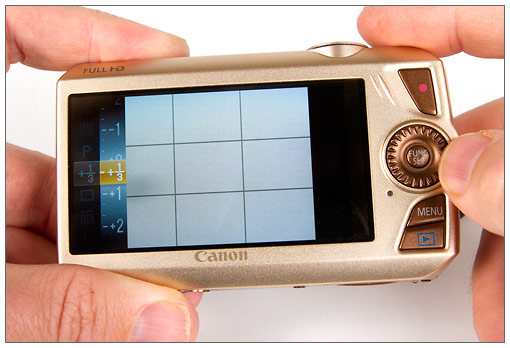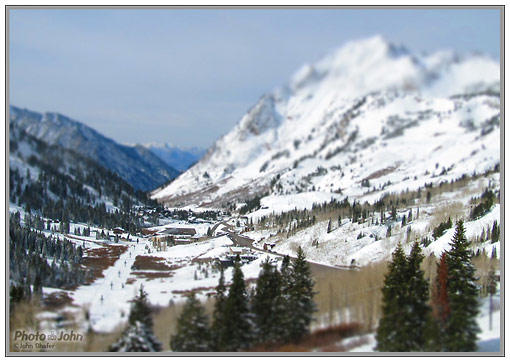The PowerShot SD4500 IS looks very similar to Canon’s top-of-the-line PowerShot S95 but the “SD” designation indicates it’s part of Canon’s consumer-oriented Digital ELPH point-and-shoot lineup. It’s about the same size as the S95 but it doesn’t have the control ring on the front or the pop-up flash and it has a flashier, shiny brown/copper finish. Personally, I prefer the professional matte black of the S95 but ultimately camera looks don’t matter to me as much as features and performance. Like the S95 and the rest of the Canon SD-Series cameras, the SD4500 fits in my pants pocket – always one of my top criteria for a point-and-shoot camera.
Canon PowerShot SD4500 IS Intro Video:
I bought the SD4500 IS for the 10x zoom lens, 1080p HD video and 8.5 FPS burst rate – all things the S95 doesn’t offer. Choosing the SD4500 IS over the S95 means giving up three things: a wider lens (28mm vs. 36mm), RAW shooting and manual exposure control. If you can live with a pure point-and-shoot, then I think the SD4500 IS delivers more pocket-sized camera for the buck. With a point-and-shoot camera I don’t really care about RAW shooting or manual exposure control. It would be nice if the SD4500 had those features but I’ll survive without them. It’s not like I can’t get good exposure with the SD4500, either. It has Program mode with exposure compensation plus a pure auto mode and 19 scene modes, including standards like Portrait, Kids & Pets, Beach, Snow; as well as some more interesting options like Miniature Effect (see below), Fish-eye Effect, Color Swap, Handheld NightScene and a panorama “Stitch Assist” mode. Some of the scene modes, like the High-speed Burst mode that got me interested in the camera, have reduced resolution, making them less than useful in my opinion.
The PowerShot SD4500 IS has full HD video – that means 1920 x 1080 resolution instead of 1280 x 720 like most point-and-shoot cameras have right now. The movie mode is easy to use, with a dedicated start/stop button. Unfortunately, the video button is exactly where my right thumb holds the camera and it’s very easy to start recording video by accident. You can zoom while recording video, which is really cool with such a wide zoom range, and Canon’s optical image stabilization works great so handheld videos aren’t a shaky mess. There’s a “Miniature Effect” video scene mode for all of you toy village / tilt-shift video fans. And the coolest video extra – for me, anyway – is the 240 FPS slow motion video mode. I haven’t tried editing the low resolution (320 x 240) slow-mo videos but you can play them back on the camera and the mountain bike and hockey clips I shot are super fun.

Notably missing from the SD4500 IS movie mode is exposure compensation adjustment. This is a completely basic control in my opinion and it’s a shame that it wasn’t included. It means you have to completely rely on auto exposure for video with no input of your own. For me, that meant ski videos were absolutely impossible because the camera compensated for the bright snow and made my video clips too dark.
I also wish the camera offered easier access to exposure compensation for still photos. Besides the zoom control and shutter release, exposure compensation is the control I use most. I prefer a camera to have a dedicated exposure compensation button for one-click access. With the SD4500 IS you press the Func/Set button on the back to open the Func menu where you can select exposure compensation (The Func menu also accesses other common controls like ISO, shooting mode, white balance, etc.) and make adjustments. It’s not too bad but a dedicated button would be better.
Next – Canon PowerShot SD4500 IS Camera Experience >>
|




Great sample shots! Is that one of the sharks game at full zoom?
Glad you like the sample photos, Thien. According to the EXIF data the Sharks photo was taken at 54.2mm and the maximum is 63mm. I don’t want to do the math but my guestimate is that works out to be something like a 300mm equivalent. It’s a lot of lens for a pocket camera
That Kernville shot…is that stroked with PS or is that straight out the camera?
Good question, Gregg. I usually indicate in the gallery if the photos have been adjusted and they usually are. The Kernville photo was adjusted a bit in Lightroom and Photoshop to get the contrast and color the way I like them. I also used a masked adjustment layer in Photoshop to lighten up everything but the sky. Like I said in the review, the only problem I had with image quality is highlights – especially skies with clouds – blowing out. That will happen with any camera but it’s a bigger problem with compacts and JPEG files and it definitely happened with the Kernville image. I did have great light for that one. It was early morning with clouds to filter the light keeping the contrast low and color saturation high.
Hmm, that would be a fun little camera for me. Not that I’m ready to replace my TZ4. And I would miss my 28mm wide angle, but the 360mm zoom is impressive.
I thought that this might interest you, Patia. I do agree about the wide-angle, though. I wish it was wider. The 360mm telephoto is really cool but there is a price to pay on the wide end. There are pocket superzooms with better wide angles. But I would be surprised if any of them can compete with the image quality of the SD4500 IS.
Well, maybe by the time I’m ready for a new pocket camera, they’ll have a wide-angle version.
Yes, there’s no Sports mode, but the Kids/Pets mode is essentially a Sports mode. Use it for action and the camera will use the fastest shutter speed possible. Page 61 of the manual. Note that focus at wide angle will be fixed at 3 feet and beyond and 9.8 feet at the maximum zoom.
I’d like to have seen some images shot with the digital tele-converter. The respective focal lengths when using [1.4x] and [2.3x] (cropping the sensor, I assume) are 50.4 – 504 mm and 82.8 – 828 mm (35mm film equivalent).
Prospective buyers should know that the Silver color SD4500 IS is available from some re-sellers. I bought a Silver model from Best Buy.
Reviewer should have read the manual about the HS Burst mode; the manual was online before the camera was on the market. Pages 67 and 173 specifically state that the image size 1824 x 1368 (M size) – “The recording pixel setting will be fixed at (1824 x 1368 pixels).”
The image quality is quite good.
Thanks for the commment, John. Where did you find the manual online? It’s still not linked on the Canon USA Web site. And even if it is, I think Canon should have been very upfront and explicit about that fast burst rate being a low-resolution scene mode.
Photo-John,
Yes, Canon should have been up front about the HS Burst mode.
The online manual has been available here for some time (I don’t see it on the Canon USA site:)
http://software.canon-europe.com/software/0039129.asp?model=
Got around to posting some images from the SD4500 IS. Also a video on Vimeo
http://jpmccormac.smugmug.com/Photography/Canon-SD4500/14733356_PAy7a#1097920717_cJcsR
http://www.vimeo.com/17041126
Hey John,
Can I ask you about something? You seem to rave about the overall image quality. But when I go and see customer reviews about this camera, a lot of them report grainy, blurry pictures. (Some also comment on this camera degrading the Canon ELPH line, indicating they have had previous success/satisfaction using past Canon cameras.) So how might you explain this? Do these people have no idea how to judge image quality? Do they not know how to take pictures? Are they holding this to too high a standard? I’ve asked this to another internet “expert”, and he basically says that those people (who are reporting subpar image quality with this camera) are clueless.
I wonder if you might amplify your experience here.
Thanks for the comment and question, John Lee, it’s a good one. More often than not, I find that complaints about camera quality are a problem with the user’s technique and not the camera. My guess is, that’s the case here. I’m still using the SD4500 IS and I’m still impressed with the image quality. The camera isn’t magic, though. And you can make bad pictures with it. Without seeing the problem photos I can’t really judge. All I can do is point to my own photos and our studio tests as proof of the actual image quality potential.
Does that answer your question? If not, please follow up and I’ll do my best to give you more information. It is a good question. I think camera marketing departments have convinced a lot of people that digital cameras are magic and that sets them up for unrealistic expectations and disappointment. no matter how good a camera is, crappy technique will result in crappy photos.
Certainly does John. Right now, I’m waffling between a few cameras, this being one of them. I’m interested in a pocketable P&S that will allow me to grow as an casual/able photographer (not just a clicker if you know what I mean). Here’s a question for you ;), regarding indoor (low-light) shooting, which this camera is purported to be more than able: From what I understand, very few pocket cams like this *actually* produce shots worthy of any premium in price.
In other words, the “HS System” that this camera boasts is *actually* a lot of hooey, in that no matter what sort of system, these cameras are limited to a few factor (lens, sensor size…) And that this camera’s low-light ablity is sort of disabled due to limitations in it’s own lens and sensor. (BTW, this is not to say I know jackdiddly about all this stuff, but like I said… I’ve really been researching this, and have hit up many knowledgeable people about these topics)
So how would you say this camera’s low-light ability, John? Despite what I mention above, I’ve actually seen some samples (pics & video) that actually show some good-looking images. Thanks for taking time to answer!
The sensor in this camera is CMOS contrary to the CCD sensor used in the S95 & G12. CMOS controls noise more efiiciently & back illuminated sensors (BSI) are really effective in low light environments. It also helps achieving higher bursts & HD videos.
However, the sensor size in this camera is 1/2.3″ versus 1/1.7″ in S95 & G12 resulting in higher pixel density which usually translates into inferior dynamic range.
It’s not easy to find a camera that meets all my needs, but the cameras equipped with BSI sensors do really deliver very good pictures.
Thanks for the added information about the sensor size, Elie! That’s really useful. I would like to include actual pixel size in all reviews but that spec is often very hard to get.
I bought this camera on eBay for $249.95. It is to replace a Powershot S1 IS that is getting cranky. I like to take photos of birds (and people too) so I do need that 10x zoom. Thanks for the good camera reviews.
Glad you liked the review, deenie. Please write your own user review for your camera after you’ve had it a bit. There’s a link for the user review page up above. How nice is it to replace your old S1 IS with a camera that fits in your pocket, huh?!
I bought this camera as well just before a trip to Mexico for a destination wedding. It took great shots in well lit situations, but when it got dark and we were in the reception area, it took a while to focus and take a photo. I was the annoying one waiting for my camera to go off. So picture a bunch of people dancing and me trying to get the shot of everyone looking and smiling as a group. It took way too long to focus and flash. I was hoping to talk to someone about it, but I’m sure I’m doing something wrong. The photos is does take are absolutely amazing. i didn’t know about the low res burst mode. that actually could be considered false advertising, no?
Low light focusing is tough for any camera, Joe. Add moving subjects and it’s next to impossible. This is where technique comes in. If I were in the same situation I’d pre-focus the camera on a still subject about the same distance as your dancing friends. Once the camera is focused, keep the shutter release button down, recompose and take your shot. That’s standard pro point-and-shoot technique
Can you compare the Canon SD4500 IS to the Nikon CoolPix S8100? According to the specs, these cameras appear to be the same, so it’s hard to decide between the two.
I have the Nikon now, but my brother and I shot photographs of the same event (a 49ers game) and the pictures shot with a Canon G12 appear to have better colors, i.e. the red of the 49er jerseys and the green of the field are more vivid in the Canon pictures. My other issue is that at 10x zoom, the Nikon is very blurry (both pictures and video).
Hey thanks for the review! I have also just bought this camera. I haven’t gotten the chance to use it much yet but so far it seems to take good pictures and video. I love having the 10x optical zoom and the full HD video at my fingertips.
One thing is when I took it out of the box I tried using it in the AUTO mode. The camera took forever to shoot the pictures and the pictures often came out blurry. I think this is the problem many people are having and why it gets such negative reviews online. I know its irrational but there are so many negative reviews out there i’m still wary of the camera. But if you say its good quality and takes good photos then I’m going to stick with it.
Hi John,
Is there a camera with 10x optical zoom and better megapixel burst shooting for around the same price range? How do the burst shots looki?
Yes, Gina. Check out the Sony, Casio and Nikon pocket superzooms.